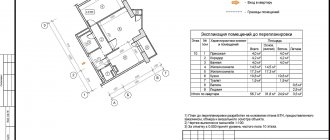Application area
At this time, unified land use as such is not applied. More precisely, new plots of this type are not appearing, since in 2008 the creation of single land use plots was canceled. However, existing areas of this type have not been converted and are still considered to be a single land use and are considered in accordance with the standards available for them.
Federal Law No. 221 of July 24, 2007 introduced the so-called multi-contour plots of land, which became an alternative to the use of single land use. The difference between multi-contour plots of land lies only in the presence of a slightly different classification of these land plots and the absence of cadastral numbers for isolated territories, that is, the cadastral number is assigned to the entire multi-contour plot and nothing more.
How to select a land plot from a single real estate object
The main innovation when using the concept of multi-contour plots was the modified classification of such plots and the absence of personal cadastral numbers for isolated plots. That is, a general cadastral number is issued exclusively for the entire multi-circuit area. What does unified land use mean? The concept of unified land use was used to improve the quality and convenience of maintaining state cadastral records.
We recommend reading: Pitfalls When Buying a Share in an Apartment
Employees of the territorial cadastral authority perform a comparative analysis of information from documents and the actual parameters and characteristics of the specified land plot. The clarification procedure is used to identify the exact coordinates of boundaries or when creating new land plots, when disbanding them and separating individual pieces.
Compound
The composition of a single land use refers to a particular number of separate plots that are part of a given plot. These plots have their own boundaries and geodetic data, are entered into the cadastral register under separate numbers and can be separately clarified, combined, etc.
It should be noted the difference between isolated and conditionally isolated areas, which lies in the location of the contours of these areas. Thus, isolated areas have a contour that is adjacent to other territories that are not part of a single land use.
Conditional plots, in turn, are adjacent, that is, adjacent to other areas of single land use, but separated by conditional cadastral boundaries.
How to obtain permission for a conditionally permitted type of use of a land plot?
A conditionally permitted use of a plot of land can be obtained after passing the following stages:
- The owner of the land plot sends an application to the local administration in order to obtain the appropriate permission for the type of use. It may require the attachment of documents, the list of which must be clarified with the authorized body. You can send it through the MFC or State Services.
- The project is subject to consideration during public hearings. In this case, all costs for their implementation are borne by the initiator of the change in the type of permitted use.
- The result of public discussions is recommendations on permission to change the URVI or refusal. Recommendations are prepared by the commission.
- The document is sent to the head of the administration, and a corresponding decision is made within three days.
View instructions for submitting an application through State Services or services of the Moscow region
Government services:
Uslugi.mosreg.ru:
Main package of documents:
- passport;
- notarized power of attorney - if the owner’s representative acts;
- suspending documents for a land plot;
- title documents for real estate objects located on this site;
- consent of the owner of the plot if the applicant leases the land;
- consent of all owners if the land is in shared ownership.
Refusal, as a rule, occurs due to the non-compliance of a plot of land with the dimensions that are the maximum in the PZZ. The owner of the allotment has the right to review the refusal received in court.
Scheme for granting permission for URVI of a land plot using the example of the Khabarovsk Territory.
Public hearings
Article 5.1 of the Civil Code establishes the procedure for holding public discussions on the issues of replacing the types of conditionally permitted use of the allotment. Any resident of the territory where the plot of land is located on which the hearing is taking place can take part in them. If there is a possibility of a negative impact on the environment due to changes in the VRI, then the owners of land adjacent to the site may be involved in the discussions.
Hearings involve the following stages:
- notification of upcoming hearings;
- placement of the project in public publications, including the media and the Internet;
- exposition of the created project;
- drawing up a protocol based on the results of the hearings;
- publication in the media of a conclusion on the results of the hearings.
All participants in the hearings during the process of placing the project and holding the exposition have the right to make their comments and suggestions in written or oral form. They are collected into minutes by the organizers of the meeting and reflected in the conclusion based on its results. Their acceptance or rejection must be reasoned and also recorded in the protocol.
Examples
The most typical example of modern single land use is horticulture, in which there are separate plots. In the cadastre, the common gardening space has its own number and is a site of single land use, in which there are plots with their own cadastral numbers, that is, separate plots.
In addition, the example of a state farm or similar agricultural enterprise, which has a common plot, but can be divided into separate ones, was previously noted.
In general, there can be a huge number of examples, but if you imagine the essence of such areas, then it is not difficult to determine whether this or that combination of areas is a single land use or not. It is only necessary to distinguish between multi-circuit areas and areas of single land use, since a different legal framework applies to them, but in general the cadastral registration system is virtually identical.
The legislative framework
The term single land use implies a certain number of separate pieces of land that form one plot. Each piece of land has personal boundaries, a cadastral number, as well as geodetic data. In addition, geodetic data can be combined.
Also, land plots are divided into 2 types:
- conditionally isolated;
- isolated.
The main difference between them is the location of the contours. Conditional land plots do not have a so-called contour. It is usually adjacent to neighboring areas that are not included in the EZ.
All conditional land plots are called adjacent. Because they are located near neighboring areas of the EZ. But at the same time, they are separated by existing borders.
Most often, the status of single land use is assigned to the lands of gardening partnerships and associations. Gardening partnerships often own land plots located separately from each other.
Each individual land plot of a gardening partnership has a corresponding number in the state land cadastre.
At the same time, they fall under the status of single land use.
Previously, large agricultural associations and enterprises owned large plots of land, which in turn could be divided into separate plots. There are many examples when lands were assigned the status of single land use.
The procedure for assigning status is very simple. Therefore, it is not difficult to determine the status of this or that piece of land. But since the concept of multi-circuit sections was introduced in 2007, it is necessary to correctly determine the status. Since these concepts have a number of fundamental differences. First of all, different legal frameworks are used. But at the same time, the accounting system is almost similar.
Methods and order of formation
For this period of time, as mentioned earlier, unified land use is not being formed; only areas that were created earlier, before 2008, exist. Since that time, a new term has appeared - a multi-circuit plot of land. The formation of such sites is regulated in accordance with Federal Law No. 221.
If it is necessary to combine two or more sections with closed contours, then a multi-contour section is formed.
There are types of formations:
- with separated contours (that is, areas adjacent to each other, but having their own contours);
- interspersed (that is, areas between which there is land that is not related to this land use).
Thus, now only multi-circuit areas are being formed, including from existing areas of single land use. For example, if it is necessary to separate a certain number of plots from a single land use, then these plots are registered as separate, and the rest become a multi-circuit plot.
To combine plots, a boundary plan is used, which is submitted to the cadastral chamber and approved by regulatory authorities.
Section of unified land use of a land plot
Section of unified land use The features of the section of previously recorded unified land use are established by paragraph 60 of the Procedure for maintaining the state real estate cadastre, approved by order of the Ministry of Justice of Russia dated February 20, 2008 No. 35. In accordance with this paragraph, when dividing unified land use, the formed land plots are assigned new cadastral numbers, and the original the land plot (single land use) remains with the same cadastral number within the changed boundaries (changed land plot). Moreover, in accordance with Article 24 of the Federal Law of July 24, 2007
The essence of the described example is that a certain owner has one plot, which can be separated by public areas (road, plot with municipal buildings, etc.), but in general the plot is in use by one owner. There are many similar examples and they can be observed not only for private individuals, but also, for example, for agricultural enterprises, which can be located in large spaces, thinned out by public areas that are not the property of this agricultural enterprise. Relatively recently, to ensure better and more convenient cadastral registration, the term “single land use” was introduced.
Clarification
There are various situations that require the so-called clarification of unified land use. In essence, the situation is similar to clarifying a separate plot of land and represents a comparison of the data available in the cadastral documentation with the actual characteristics of the plots. Clarification is used to form new areas or, more precisely, to determine the boundaries of existing areas and similar purposes.
This process involves the creation of a boundary plan, which includes information about the available areas.
Based on the results of clarification by cadastral service employees, changes may be made to cadastral documentation, plots may be reorganized (merged, divided, separated) and other parameters used in cadastral documentation and actual land use may change.
How is it done?
The most common option for performing clarification is the use of specialized programs that make it possible to competently and carefully draw up a boundary plan for carrying out clarification. There are a number of common programs that are used for this purpose and provide, after filling out certain information, an XML document, that is, detailed tables with a boundary plan.
As a rule, programs have a clear interface and there you need to enter:
- cadastral number of the plot;
- the presence or absence of newly formed areas, their coordinates;
- the number of specified areas in a single land use;
- cadastral numbers of the areas being specified;
- other information about the areas being specified.
After entering the indicated data, the program will provide a boundary plan, although it is possible to create such a plan simply in an Excel table, but this method is not advisable, given the accessibility and availability of specialized software.
Issues of legal regulation of unified land use and its division
The introduction of the concept of “single land use” dates back to the time of the Federal Law “On the State Land Cadastre” dated January 2, 2000 No. 28-FZ.
There has been a long debate among legislators about the possibility of recognizing a land plot as a complex object, which may include several parts. And finally, the Government of the Russian Federation adopted a resolution approving the Rules for the cadastral division of the territory of the Russian Federation No. 660 dated September 6, 2000 (8 months after the adoption of Law No. 28-FZ), which introduced the concept of “composite land plot” into use, which later received another the name in the cadastral plan is “single land use”. Today, both of these acts have lost force and are no longer in effect. From this moment on, the owner of several separate plots could register them as one piece of real estate and receive one cadastral number for it. In the future, the owner could dispose of both the composite plot as a whole and its individual parts, for which purpose a division of single land use was previously carried out. The status of a composite plot was retained if at least 2 separate plots remained in a single land use after the division.
Useful tips
The information provided will help to better understand the area of unified land use.
Let's briefly summarize the above:
- Unified land use is a plot with its own cadastral number, which includes united plots of land with their own contours and cadastral numbers.
- Legal regulation of this area is carried out on the basis of cadastral registration norms and Federal laws.
- Since 2008, single land use has been abolished and multi-circuit plots have appeared in its place.
- In this area, new clarifications and additions to regulations and orders regularly appear, which should be taken into account when carrying out various processes with unified land use.
- In order to draw up a boundary plan to clarify areas, it is advisable to use specialized software.
Of course, each specific option for single land use is unique, and in order to fulfill certain needs of the owners of the site, it is necessary to study in detail the possible options for using such a site and interaction with cadastral registration authorities. The information provided provides only a generalized understanding of this land use order.
What are composite sections called now?
Federal Law No. 28-FZ ceased to apply with the entry into force of the new federal law “On the State Real Estate Cadastre” dated June 24, 2007 No. 221-FZ. Along with it, a new concept appeared in land legislation - “multi-circuit plot”, replacing the wording “single land use”.
In addition, the Government of the Russian Federation, by Resolution No. 469 of June 14, 2011, declared its own Resolution No. 660 to be no longer in force. Although the principles of territorial division were preserved, certain terms were replaced. The new rules were reflected in the order of the Ministry of Economic Development No. 144 of April 4, 2011, which is also no longer in effect today.
Important! From January 1, 2021, the procedure for cadastral division of the territory of the Russian Federation, approved by order of the Ministry of Economic Development No. 877 of November 24, 2015, was introduced.
Subscribe to our newsletter
Yandex.Zen VKontakte Telegram
The concept of multi-circuit assumes that each individual section has its own closed circuit. A multi-circuit section contains several sections with closed contours. Despite the apparent similarity with single land use, there are a number of differences:
- The single land use included separate plots, which could also have their own cadastral numbers. Individual contours within a multi-circuit area are not real estate objects, they are simply territories delineated by the boundaries.
- Contours cannot have common boundaries, but a single land use could include conditional (adjacent) areas.
Because of these differences, areas previously recorded as single land uses are not renamed as multi-contour areas, but continue to exist under the same names and with the same characteristics in the cadastre.






